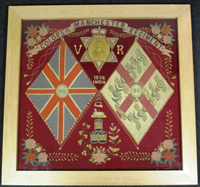Regimental Embroidery

We don’t know who made this embroidery nor who the soldier is in the photograph. We believe the embroidery was completed in India in 1896.
What do all he symbols and words on the embroidery mean?
What does ‘V’ ‘R’ mean? (top centre)
This means ‘Victoria Regina’. The word Regina is Latin and means ‘Queen’. These 2 letters date the embroidery to the reign of Queen Victoria (1837 to 1901).
The Colours
The main feature of the embroidery are 2 flags or ‘Colours’.
What is a ‘Colour’?
The Colours have become the symbol of the spirit of the Regiment, for they bear the battle honours and badges granted to the Regiment on commemoration of the gallant deeds performed by its members from the time it was raised.
The association of colours with heroic deeds has caused them to be regarded with veneration. The fact that colours are consecrated before being taken into use, and are laid up in sacred or public buildings after service serves to maintain the atmosphere of veneration with which they are surrounded
Each infantry battalion had 2 colours, collectively called ‘a stand’; the King’s (or Queen’s) colour (on the left in the embroidery) and a ‘regimental colour’ (on the right in the embroidery).
Visit the Museum’s ‘Object Focus’ webpage to learn more about our Regimental Colours.
What do the places mentioned on the colours mean?
These are some of the Regiment’s ‘Battle Honours’. These are key campaigns that the Regiment fought in, since the time is was raised, that are remembered, by the Regiment, through the ages.
The Battle Honours mentioned here are:
- Guadaloupe
- Egmont-op-Zee
- New Zealand
- Inkerman
- Sevastopol
- Martinique
- Peninsula
- Alma
- Afghanistan
- Egypt
- Egypt 1882
Visit the Museum’s ‘Regimental History’ webpage to learn more about these campaigns and our other Battle Honours.
The Sphinx (Egypt) (bottom centre)
This is a symbol used by the Regiment to remember its fighting during the Egyptian campaign, fought between 8th March and 26th August 1801 with the aim of expelling Napoleon Bonaparte from Egypt.
On 16 July 1802, Egypt, with the badge of The Sphinx was awarded to all units which had taken part in the 1801 campaign. This distinction is interesting for several reasons: it was the first to be awarded for a campaign and the first to use a badge to commemorate the award. Also, unlike previous awards, it was not considered necessary for the complete unit to have been present to qualify for the honour.
The Regiment was once again in Egypt in 1882 (11 July to 23rd September 1882) – when it earned the battle honour Egypt 1882, awarded in 1883.
The other symbols on the embroidery
- The flowers embroidered on the work depict the constituent countries of what was called the United Kingdom of Great Britain and Ireland: the rose of England, the thistle of Scotland and the Shamrock for Ireland (Ireland was not independent until 1922).
- ‘96’ refers to the 96th Regiment of Foot which later became the 2nd Battalion of the Manchester Regiment.
- The Crowns reflect the service of the regiment and soldier to the monarch of the day, in this case Queen Victoria.
- Three drums and a bugle are depicted on the embroidery. Both these instruments would be familiar to any soldier both in the 1800’s and still today.
This embroidery was conserved by Mrs Jacqueline Hyman and framed by Lancashire County Museum Service with financial assistance from the Army Museums Ogilby Trust in 2013.

